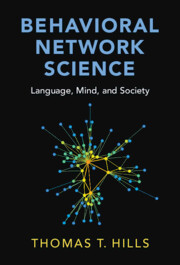Book contents
- Frontmatter
- Contents
- Additional Resources
- Introduction: Structure Matters
- Part I A Brief Guide to Network Science
- Part II Language
- Part III Mind
- 10 False Memories: Spreading Activation in Memory Networks
- 11 Cognitive Foraging: Exploration versus Exploitation
- 12 Age-Related Cognitive Decline: A Network Enrichment Account
- 13 Creativity: How Noisy Processes Create Novel Structure
- Part IV Society
- References
- Index
10 - False Memories: Spreading Activation in Memory Networks
from Part III - Mind
Published online by Cambridge University Press: 08 November 2024
- Frontmatter
- Contents
- Additional Resources
- Introduction: Structure Matters
- Part I A Brief Guide to Network Science
- Part II Language
- Part III Mind
- 10 False Memories: Spreading Activation in Memory Networks
- 11 Cognitive Foraging: Exploration versus Exploitation
- 12 Age-Related Cognitive Decline: A Network Enrichment Account
- 13 Creativity: How Noisy Processes Create Novel Structure
- Part IV Society
- References
- Index
Summary
What is memory? Scientists have proposed a wide variety of spatial metaphors to understand it. These range from the 2D wax tablets proposed by Plato and Aristotle and subsequently Freud, with his magic writing pad, to the 3D physical spaces that one can walk around inside, such as the subway of Collins and Quillian. If memory has such a spatial structure, then it suggests a simple rule: items in memory can be near or far from one another. Anything with a near-and-far structure lends itself to a network representation. Such spatial structure also lends itself to being in the wrong place at the wrong time: remembering things that never happened and forgetting things that did. This chapter explores how structure facilitates memories and also looks at a specific case of false memory to highlight how modeling the process of spreading activation on networks can enrich our understanding of structure beyond degree.
Keywords
Information
- Type
- Chapter
- Information
- Behavioral Network ScienceLanguage, Mind, and Society, pp. 143 - 160Publisher: Cambridge University PressPrint publication year: 2024
